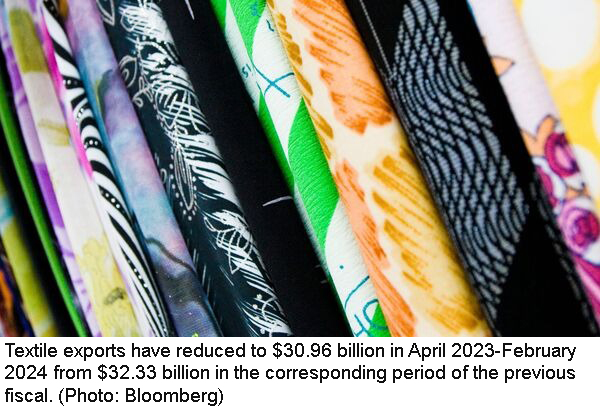
Category: General
Country: India
Region: South Asia
During the 11 months till February, the export of ready-made garments fell to $13.05 billion from $14.73 billion in the corresponding period a year ago. The export of jute declined to $310 million from $400 million, while yarn shipments fell from $4.47 billion to $4.23 billion.
By Dhirendra Kumar
24th March 2024, 04:46 PM IST
2 min read
New Delhi: India's textile exports shrank 4.2% year-on-year (yoy) in the first 11 months of the current financial year, hurt by adverse economic conditions in major destinations such as the European Union (EU), the US, and West Asian nations, according to the commerce ministry data analyzed by Mint.
India exported textiles worth $30.96 billion during April 2023-February 2024, down from $32.33 billion in the corresponding period of the previous fiscal year.
"The possibility of a course-correction in the upcoming months is bleak, and the downward trend is expected to continue in March as well. Adverse economic conditions, coupled with the Red Sea crisis, are impacting the export of textile products, including ready-made garments, to foreign destinations," a senior government official, who requested not to be identified, said.
During the 11 months till February, the export of ready-made garments fell to $13.05 billion from $14.73 billion in the corresponding months of the previous fiscal year. Similarly, the export of jute declined to $310 million from $400 million, while yarn exports fell from $4.47 billion to $4.23 billion.
The export performance of different categories in the textile sector varied during the current fiscal year. The export of ready-made garments contracted by 11.4%, while jute exports saw a more significant contraction of 22.5%. Yarn exports also experienced a contraction, albeit at a lower rate of 5.3%.
However, industry experts are hopeful that exports will improve in the upcoming months, especially with the US market showing signs of revival.
According to Crisil, India’s textile industry is expected to grow in calendar year 2024, driven by a consistent improvement in domestic demand, gradual recovery in exports, and lower cotton prices.
“Adverse economic conditions in Western markets have indeed had a negative impact on textile and apparel exports. Some of these challenges can be overcome by exploring markets in the east such as Japan and Korea along with a focus on natural fibres and cotton which will continue to see growth in demand," said Anand Ramanathan, partner, consumer industry leader, consulting, Deloitte India.
"Also, the luxury sector is relatively immune to economic cycles and can be an opportunity for India's rich tradition in weaving and embroidery," Ramanathan added.
The main buyers of Indian ready-made garments (RMG) are European nations led by Germany, the Netherlands, Italy, Poland and Denmark.
Queries sent to the textiles ministry remained unanswered till press time.
As Yemen's Houthi militants continue to target ships in the Red Sea, Indian exports are facing higher shipping costs due to rerouting from Africa. Around 95% of vessels have rerouted around the Cape of Good Hope, adding 4,000-6,000 nautical miles and 14-20 days to journeys, the commerce ministry had stated in a report last month, a copy of which has been seen by Mint.
India is the world’s sixth-largest exporter of textiles and apparel, with the domestic apparel and textile industry contributing about 2.3% to the country’s GDP, 13% to industrial production, and 12% to exports.
India’s textile and apparel market size is growing at a CAGR of 14.59% from $172.3 billion in 2022 and is expected to reach $387.3 billion by 2028, according to Indian Brand Equity Foundation (IBEF), a body established by the ministry of commerce and industry.
The textile industry is also the second-largest employer after agriculture, providing direct employment to 45 million people and 100 million people in the allied sector.
Courtesy: Livemint.com
Copyrights © 2025 GLOBAL TEXTILE SOURCE. All rights reserved.